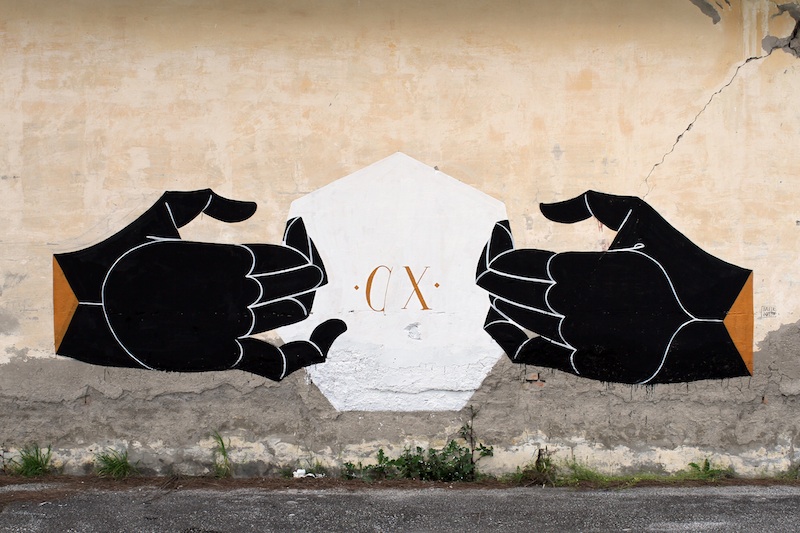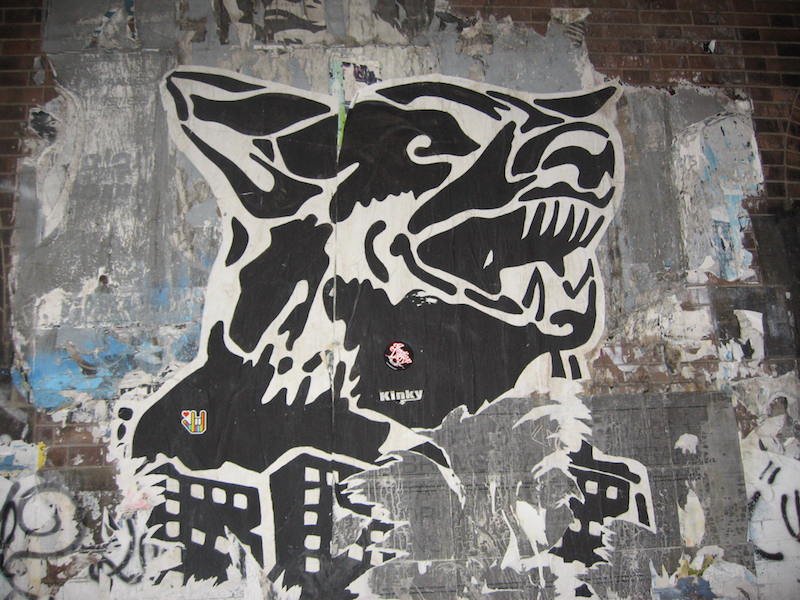
Goatse by Basik, based on the goatse.cx meme. Photo by Basik.
The entire world has been changed by the web, so it may seem that this little community of street art is no different than any other arts community or niche community. After all, niche communities of all kinds have connected and been built up online. That artists in New York City can inspire an artist in Arizona shouldn’t surprise most people who have been paying attention these past few years. But that doesn’t mean it isn’t still miraculous, and it is nothing short of miraculous that street artists from around the world can now share their art with a global fan base and be inspired by art exists thousands of miles away from where they live. These advances have changed the landscape of street art and graffiti forever.
The internet and cheap cameras have also opened up unexpected doors. Street artists and graffiti writers can and practically must produce work on the street that addresses a primarily digital audience. While the online consumption of street art and graffiti has closed some doors (fewer artists using local styles and fans consuming art about and in the city while sitting on their asses instead of actually walking around the city and seeing things for themselves), it has opened countless windows. Street art has had an explosive growth in popularity over the last decade, and it has also undergone significant changes in that time. As I’ve shown in the last two chapters, many of those changes can be linked directly to the internet, and some of that growth in popularity, particularly for street art can probably be linked as well.
Not all of the changes that the internet has brought for street art and graffiti have been positive, but here’s the story of possibility that I believe trumps any negative effects that the internet has on street art or graffiti:
- An artist in Berlin can send me a photo something the have just painted on the street.
- Within an hour, I can post that photo to my blog while sitting in my dorm room on a college campus in the suburbs of Philadelphia.
- My post immediately pops up in the RSS reader of a middle-school kid sitting in his room in a lame Chicago suburb.
- That kid is inspired to create something amazing and disruptive based on what a stranger painted in Berlin.

Wheatpaste by Faile. Photo by urban_data.
Despite all the possible downsides of street art appearing on the internet, it seems that many street artists do still want to have their work featured on blogs and elsewhere on the internet. Faile’s Patrick Miller told me, “Blogs are a vital part of sharing work online and through social media, they can reach hundreds of thousands of people in a day. If we didn’t have the ability to share work this way, so many less people would come across our art. As much as we want to transcend street art as a label, we’re grateful there is such a huge community following and sharing the work. It can have a long life online far after it’s disappeared from the street.”
Tanley Wong of Arrested Motion argues that seeing street art online can help people to care about it in person. And that’s true. Seeing a photo of street art is kind of like seeing a Where’s Waldo? drawing with everything in black and white except Waldo, who is still in full color. Suddenly, something that might have been hidden is revealed. Is that as fun as a regular Where’s Waldo? No, but it helps you know what you’re looking for the next time you see a Where’s Waldo? in full color. Although it’s not always the case, seeing a photo of street art can help the viewer open their eyes to seeing street art when they are on the street, street art that they might otherwise have missed. This works on the level of street art and graffiti in general, but also at the level of individual artists and writers. There’s no doubt in my mind that being conscious of street art and graffiti makes you look at cities in a different way, and that process of transformation can be jump started by documentation.
But maybe you just can’t see the internet as having been a positive thing for street art or graffiti. Just because street art or graffiti that’s intended to be consumed on the internet can be frustrating at times does not mean we should discard the possibility of digital street art.
Street art documentation shared online is, at worst, the manifestation of street art’s annoying teenage years as it’s still finding its footing in the digital environment. That photo, or a photo of graffiti, is hardly different from an animated GIF or a photo of a traditional painting once those things all end up together on Tumblr. None of those artworks take full advantage of the internet, but the street art and graffiti worlds are uniquely poised to do so because the people in these scenes understand the value of and how to invade public space. Street art and graffiti still have the possibility to develop further as more people in these movements figure out how their work can exist online. Only a handful of street artists and graffiti writers have taken full advantage of the internet and used it to create work that can excite in the same way that turning a corner to come across an amazing and unexpected wheatpaste can excite. Those artists who have used the internet well are the focus of the next chapter.
In the last two chapters, I’ve examined many of the changes that have already occurred since the arrival of the internet. In the final chapter of this book, I want to go a step further and look at how, at a time when most street art and graffiti is seen online and some artists are adapting their work to this new situation, artists can further evolve to create work that exists natively in digital public spaces without leaving street art or graffiti behind.
We in the street art community should expand how we understand placing art in public spaces. If the deepest values of street art and graffiti are not to be left behind in an increasingly digital world, we also have to embrace what I call viral art, art that emulates street art and graffiti in digital public spaces. Through viral art, the goals and values of street art and graffiti have a bright future online, a future that artists have only begun to explore. This chapter was about clever artists allowing the internet to mold their street art and graffiti. The final chapter is about the clever artists allowing the internet to mold their digital art and the truly brilliant artists are using their art to mold the internet.